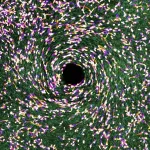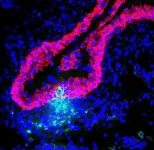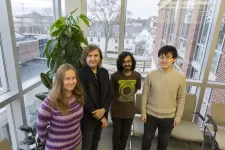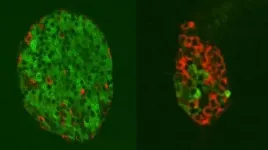(Press-News.org) CORVALLIS, Ore. - Oregon State University research has revealed a crucial mechanism behind one of humankind's most deadly physiological processes: the movement of malignant cells from one part of the body to another.
Published in the Proceedings of the National Academy of Sciences, the study led by OSU biophysicist Bo Sun shows the role that tissues' microscopic geometry plays in cancer metastasis, the internal spreading of the disease that's responsible for 95% of all cancer deaths.
To develop drugs that effectively combat metastasis, it's fundamentally important to understand what directs the metastatic process, Sun said.
"Our results show the level of tissue fiber alignment, particularly collagen fiber alignment, is a crucial part of what's happening," Sun said.
Collagen is a protein that serves as the primary component of human connective tissue, which supports, protects and provides structure for other tissues and organs in the body. Collagen is also a key part of the extracellular matrix, the non-cellular part of tissues and organs that acts as a scaffold and also performs important biochemical and biomechanical functions.
"Clinical studies have shown that the microscopic geometry of tissue is significantly correlated with the progression of breast cancers," Sun said. "Our study reveals the underlying biophysical mechanism. In the era of precision medicine, we think taking into account the physical properties of a patient's tissue can be critical for the prediction and treatment of metastatic disease."
The correlation is due to a cellular phenomenon known as "contact guidance," which is analogous to a back-country hiker trying to pick a route based on the contours of the terrain and the network of downed trees on the ground.
"In navigating the three-dimensional extracellular matrix, where the fibers aren't necessarily parallel, cells have to integrate multiple guidance cues that aren't always clear and sometimes are conflicting," Sun said. "Understanding the mechanisms and limitations of cell responses to imperfect guidance signals is pivotal for predicting and engineering cell behaviors - i.e., providing a patient with a precise diagnosis, prognosis and treatment."
¬¬In this research, Sun and collaborators at OSU, the University of California San Diego and Northeastern University found that a breast cancer cell can switch between two distinct states: the mesenchymal, in which the cell shape is elongated, and the amoeboidal, in which it's more round.
"In the mesenchymal state, a cell follows the orientation of tissue fibers, and the effect is strongest when the level of fiber alignment is highest," Sun said. "In the amoeboidal state, the same cell moves rather randomly. Another part of it is that the transition rate between the two states is also determined by the level of tissue fiber alignment - strong alignment leads to a stronger tendency for a cell to stay in the mesenchymal state."
Collaborating with Sun were graduate research assistant Jihan Kim and Ph.D. candidate Christopher Eddy of OSU's Department of Physics, Yuansheng Cao and Wouter-Jan Rappel of UC San Diego, and Youyuan Deng and Herbert Levine of Northeastern.
The U.S. Department of Defense, the National Science Foundation and the National Institute of General Medical Sciences supported this study, which builds on earlier research by Sun that showed human cells, including cancer cells, could mechanically and permanently remodel their surroundings - and thus affect an array of physiological processes from metastasis to wound healing to embryo development.
In that research, Sun found that a single pair of breast cancer cells could increase the local fiber density of reconstituted collagen matrices by more than 150%.
"Mechanical remodeling is an early event that triggers a cascade of amplifying events that lead to chemical remodeling," Sun said. "With breast cancer, a lump can be felt because the cancer has solidified a large region around it. Our tissue is trying to relax the cancer cell-generated stress and in so doing goes through unrecoverable aging."
INFORMATION:
A University of Melbourne led study has established how plants use their metabolism to tell time and know when to grow - a discovery that could help leverage growing crops in different environments, including different seasons, different latitudes or even in artificial environments and vertical gardens.
Published in the PNAS journal, Superoxide is promoted by sucrose and affects amplitude of circadian rhythms in the evening, details how plants use their metabolism to sense time at dusk and help conserve energy produced from sunlight during the day.
Lead ...
DURHAM, N.C. - Anyone who has ever developed a urinary tract infection (UTI) knows that it can be painful, pesky and persistent. UTIs have a high recurrence rate and primarily afflict women -- as many as 50% of women will experience at least one UTI during their lifetime.
However, what if patients could take a vaccine that would prevent future UTIs? In a March 1 study in the Proceedings of the National Academy of Sciences, Duke researchers describe a new vaccination strategy that they think could re-program the body to fight off the bacteria that cause urinary tract infections.
"Although several vaccines against UTIs have been investigated in clinical trials, they have so far had limited success," said Soman Abraham, Ph.D., Grace Kerby Distinguished Professor of Pathology, Immunology ...
A new study from Boston Children's Hospital and the Massachusetts Department of Health compared one of the latest rapid antigen tests for COVID-19 -- the Abbott BinaxNOW -- with a highly accurate PCR test in a high-volume, drive-thru testing environment. They found that the rapid test detected almost all adults who tested positive by PCR if they had had symptoms lasting seven days or less. In symptomatic children with less than seven days of symptoms, the test picked up about 85 percent of true positive cases.
But no matter the age, if the patient had high amounts of virus in their nose, the test caught it 99 percent of the time. It was also able to rule out COVID-19 ...
The human gut consists of a complex community of microbes that consume and secrete hundreds of small molecules--a phenomenon called cross-feeding. However, it is challenging to study these processes experimentally. A new study, published in END ...
Researchers from Skoltech and the University of Cambridge have shown that polaritons, the quirky particles that may end up running the quantum supercomputers of the future, can form structures behaving like molecules - and these "artificial molecules" can potentially be engineered on demand. The paper outlining these results was published in the journal Physical Review B Letters.
Polaritons are quantum particles that consist of a photon and an exciton, another quasiparticle, marrying light and matter in a curious union that opens up a multitude of possibilities in next-generation polaritonic devices. Alexander Johnston, Kirill Kalinin and Natalia Berloff, professor at the Skoltech Center for Photonics and Quantum Materials ...
A group of researchers representing four countries summed up the results of the Supertest, a large-scale study of the academic performance of engineering students in Russia, China, India, and the United States. It is the first study to track the progress of students in computer science and electrical engineering over the course of their studies with regard to their abilities in physics, mathematics, and critical thinking and compare the results among four countries. The article about study in Nature Human Behavior.
The HSE Institute of Education played a key role not only in collecting and analyzing data from Russia, ...
March 1, 2021 - Benign bone tumors may be present in nearly 20 percent of healthy children, based on a review of historical radiographs in The Journal of Bone & Joint Surgery. The journal is published in the Lippincott portfolio in partnership with Wolters Kluwer.
Although that may sound frightening, non-ossifying fibromas and other common benign bone tumors in symptom-free children are harmless and may resolve over time, reports the new study by Christopher D. Collier, MD, of Indiana University School of Medicine and colleagues. "These findings provide unique evidence to answer many commonly encountered questions when counseling patients and their families on benign bone tumors," the researchers write.
Study offers reassurance that benign ...
Blocking cell receptors for glucagon, the counter-hormone to insulin, cured mouse models of diabetes by converting glucagon-producing cells into insulin producers instead, a team led by UT Southwestern reports in a new study. The END ...
Boston, MA--Most pregnant women and mothers of children younger than 18 years old say they would receive a COVID-19 vaccine and vaccinate their children, according to a survey conducted by researchers at Harvard T.H. Chan School of Public Health. The research indicated that vaccine acceptance was highest in India, the Philippines, and all sampled countries in Latin America, and it was lowest in Russia, the U.S., and Australia.
The results will be published online on March 1, 2021 in the European Journal of Epidemiology.
Vaccines for COVID-19 are being distributed around the world, but until ...
SILVER SPRING, Md. - A recent preclinical study by U.S. Military HIV Research Program (MHRP) researchers showed that an experimental therapy combining a TLR7 agonist and two broadly neutralizing antibodies delayed viral rebound in SHIV-infected macaques after antiretroviral therapy (ART) interruption.
The experimental combination therapy consisted of TLR7 agonist GS-986 and two broadly neutralizing antibodies (bnAbs), N6-LS and PGT121, targeting different regions of the HIV envelope. The rhesus macaques were initiated on viral suppressive antiretroviral therapy 14 days post infection, a timespan from infection to treatment which mirrors what is feasible in acute HIV infection. Researchers then administered the experimental combination ...





